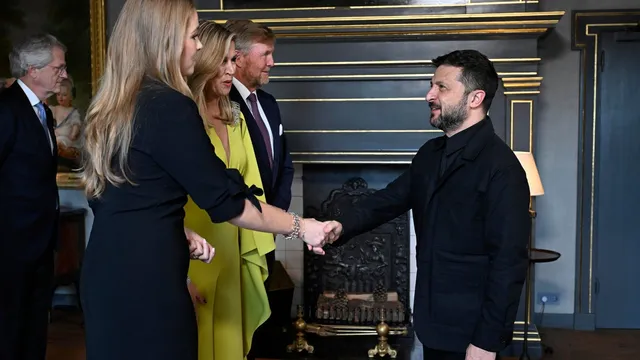
Zelensky warns of impending Russian threat to NATO countries
2025-06-25 15:12- Volodymyr Zelensky claimed that Russia might initiate attacks on NATO countries within five years.
- Zelensky criticized NATO's planned increase in defense spending as inadequate to counter Russian threats.
- The current situation highlights the urgent need for NATO to support Ukraine as part of European security.
Express your sentiment!
Insights
Ukraine's President Volodymyr Zelensky expressed grave concerns about potential Russian aggression toward NATO countries during a recent interview and discussions at NATO gatherings. On June 23, 2025, he indicated that Russia could attack a NATO nation within the next five years as part of its broader military ambitions, which reach beyond Ukraine. Zelensky stated that the slow increase of NATO defense spending to five percent of GDP by 2035 would not adequately prepare the alliance against potential threats from Russia, which may enhance its military capabilities significantly by 2030. This warning came amid ongoing NATO meetings, where he voiced the urgency for NATO to recognize the risks posed by Russia. Zelensky claimed that Russian military operations were being planned in Europe, pointing to a dangerous escalation in military ambitions. He referenced information from Ukraine's military intelligence that suggested Russia had tangible plans to target specific European territories. Zelensky underscored that ongoing struggles against Russia were urgent for Europe’s security, emphasizing that Ukraine's resilience serves as a protective barrier for European nations. During his remarks, he pressed NATO leaders to acknowledge that the defense of Ukraine is tantamount to the defense of Europe, calling on European leaders to understand the importance of continued support for Ukraine amid shifting global focus toward other geopolitical issues. Moreover, he attributed rising military threats to opportunistic maneuvers by Russia, which could leverage international distractions to launch surprise aggressions against NATO countries. Zelensky's assertive comments coincided with NATO Secretary General Mark Rutte’s speculation regarding potential distractions orchestrated by Russia, such as a hypothetical collaboration with China to divert NATO's attention. Overall, the situation reflects a tense global security landscape where Ukraine is front and center in the discussion of NATO’s future readiness. As the ongoing conflict engulfs Ukraine, the historical context of Russia's military strategies creates a pressing need for NATO to evolve in its defense posture. The implications of this continued threat are profound, potentially altering the stability of European security and warranting a unified response within the alliance to deter Russian aggression effectively.
Contexts
The history of Russian invasions of NATO countries is a subject marked by geopolitical tensions, military strategies, and complex historical relations. Since its establishment in 1949, NATO has always been perceived by Russia as a threat to its sphere of influence and security. The post-Cold War era witnessed a significant shift in the balance of power, with NATO expanding eastward into former Soviet states, leading to Russian concerns about encirclement and loss of influence in the region. This feeling of vulnerability has been compounded by various conflicts, influencing Russia’s actions toward NATO countries, most notably in the 21st century. The most significant incursions can be traced back to the Russo-Georgian War in 2008, where Russia intervened militarily in the region of South Ossetia, which it recognized as independent against NATO's expressed opposition. This conflict marked a turning point as it illustrated Russia's willingness to use military force in areas close to NATO nations, signaling a shift in its foreign policy strategy. The annexation of Crimea in 2014 further intensified the situation, following Ukraine's aspiration for closer ties with the West and NATO. Russia's actions were met with widespread condemnation from NATO, which initiated measures to bolster the defenses of its Eastern European members, thereby heightening tensions between Russia and the alliance. The impact of these invasions has not only reshaped military posturing but also influenced NATO's collective security policies. In response to the perceived threat from Russia, NATO launched initiatives such as increased troop deployments in Eastern Europe and enhanced military readiness measures. Exercises such as the Saber Strike serve to demonstrate NATO’s commitment to collective defense, reaffirming Article 5 of the NATO Treaty, which asserts that an attack against one member is an attack against all. The ongoing activities of Russia in the Baltic states and its engagement in hybrid warfare tactics, including cyber attacks and disinformation campaigns, represent a new dimension to the challenges NATO faces. As of 2025, the historical context of Russian invasions reflects an ongoing state of strategic rivalry. NATO's commitment to collective defense continues to evolve in reaction to Russian military developments, while diplomatic efforts to stabilize the situation often fluctuate. The narrative between Russia and NATO remains inherently tied to the balance of power in Europe, where security concerns drive defense policies and military alliances. Understanding this historical backdrop is crucial for analyzing current events and anticipating future interactions between NATO and Russia, as both entities navigate a complex and often contentious landscape.